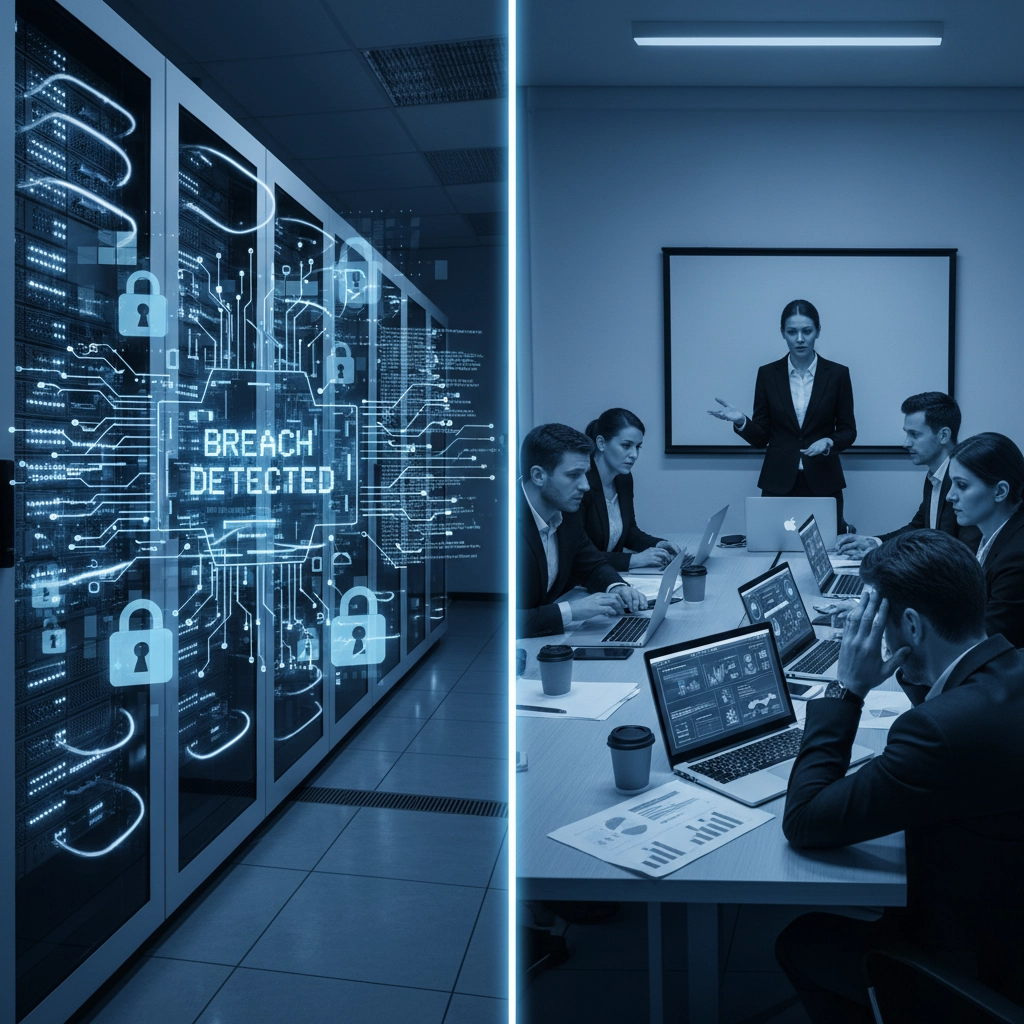If you’re running a business in Australia, chances are you’ve heard some “advice” about cybersecurity that sounds perfectly reasonable. Problem is, much of what passes for common wisdom in the cyber world is actually putting your business at serious risk.
These myths aren’t just harmless misconceptions – they’re creating dangerous blind spots that cybercriminals are actively exploiting across the country. Let’s bust some of these myths wide open and get your business properly protected.
Myth 1: “We’re Too Small to Be Targeted”
This is probably the most dangerous myth floating around Australian SMEs. Many business owners think their company is too insignificant for hackers to bother with – after all, wouldn’t criminals go after the big fish instead?
Why It’s Wrong: Cybercriminals don’t care about your company size; they care about easy targets. In fact, 43% of all cyberattacks specifically target small businesses. Why? Because smaller companies often have weaker security measures but still handle valuable data like customer information, financial records, and business secrets.
The Real Risk: Small businesses are actually more attractive to hackers because they typically lack the sophisticated security infrastructure that larger companies invest in. You’re not flying under the radar – you’re sitting there with a big “easy target” sign.
What You Should Do Instead:
- Invest in basic security essentials like firewalls and antivirus software
- Implement multi-factor authentication across all business accounts
- Train your team to recognise phishing attempts
- Consider partnering with a managed IT provider for professional security oversight
Myth 2: “Antivirus Software Is All We Need”
Many Aussie businesses think installing antivirus software ticks the cybersecurity box. Set it, forget it, and you’re protected, right? Unfortunately, it’s not that simple anymore.
Why It’s Wrong: Traditional antivirus solutions only catch about 40% of modern threats. Today’s cybercriminals use sophisticated techniques that easily bypass standard antivirus programs. Plus, many attacks don’t even involve malware – think phishing emails, social engineering, or compromised credentials.
The Real Risk: Relying solely on antivirus creates a false sense of security. While you think you’re protected, attackers are using methods your antivirus can’t detect, like advanced persistent threats, zero-day exploits, or simply tricking employees into handing over login details.
What You Should Do Instead:
- Use antivirus as one layer in a multi-layered security approach
- Add endpoint detection and response (EDR) solutions
- Implement email security filters
- Keep all software and systems regularly updated
- Focus heavily on employee cybersecurity training
Myth 3: “Our Firewall Keeps Everything Out”
Firewalls are brilliant – they’re like having a bouncer at the door of your network. But some businesses treat them like an impenetrable fortress wall, assuming nothing bad can get through.
Why It’s Wrong: Firewalls are designed to control network traffic, but they can’t protect against every type of attack. They won’t stop an employee from clicking a malicious email link, downloading infected files, or falling for social engineering scams. Plus, misconfigured firewalls can have security gaps.
The Real Risk: About 68% of businesses that experienced cyberattacks had firewalls in place. Attackers have learned to work around, through, or despite firewall protection using tactics like phishing, insider threats, or exploiting vulnerabilities in applications.
What You Should Do Instead:
- Keep your firewall properly configured and regularly updated
- Combine firewall protection with intrusion detection systems
- Monitor network traffic for unusual activity
- Focus on securing endpoints and educating users
- Regular security audits to identify potential gaps
Myth 4: “Strong Passwords Are Enough”
We’ve all been told to create complex passwords with numbers, symbols, and mixed cases. While strong passwords are important, many businesses think that’s where security ends.
Why It’s Wrong: Even the strongest password can be compromised through data breaches, phishing attacks, or social engineering. Cybercriminals use sophisticated tools that can crack passwords or simply trick people into revealing them. The 2023 Verizon Data Breach report found that 81% of hacking-related breaches involved compromised passwords.
The Real Risk: Password-only security leaves you vulnerable to credential stuffing attacks, brute force attempts, and the simple human error of reusing passwords across multiple platforms.
What You Should Do Instead:
- Implement multi-factor authentication (MFA) on all business accounts
- Use a business password manager to generate and store unique passwords
- Regular password audits to identify weak or reused passwords
- Educate staff about password security and phishing recognition
- Consider passwordless authentication solutions where possible
Myth 5: “Cybersecurity Is Just About Prevention”
Many Australian businesses focus all their energy on keeping the bad guys out. Firewalls up, antivirus running, staff trained – job done! While prevention is crucial, it’s only half the story.
Why It’s Wrong: No system is 100% secure, and determined attackers will eventually find a way in. The question isn’t if you’ll face a security incident, but when and how quickly you can respond. Focusing only on prevention leaves you unprepared for the inevitable breach.
The Real Risk: When prevention fails (and it will), businesses without response plans face extended downtime, greater data loss, higher costs, and potential regulatory penalties. The average cost of a data breach in Australia is now over $3 million.
What You Should Do Instead:
- Develop and regularly test an incident response plan
- Implement robust backup and recovery systems
- Set up monitoring and alerting for suspicious activity
- Consider cyber insurance as part of your risk management strategy
- Practice breach scenarios with your team
- Have relationships established with cybersecurity experts before you need them
Myth 6: “Cybersecurity Is the IT Department’s Job”
This might be the most organisationally dangerous myth of all. Many business leaders think cybersecurity lives entirely in the IT department’s wheelhouse and wash their hands of the responsibility.
Why It’s Wrong: Cybersecurity affects every person, process, and system in your business. While IT handles the technical aspects, successful cybersecurity requires company-wide awareness, appropriate budgets, executive support, and cultural commitment to security practices.
The Real Risk: When cybersecurity is siloed in IT, other departments may ignore security protocols, executives may underfund security initiatives, and employees may not understand their role in protecting the business. This creates massive vulnerability gaps that attackers exploit daily.
What You Should Do Instead:
- Make cybersecurity a board-level priority with executive sponsorship
- Ensure adequate budget allocation for security tools and training
- Implement company-wide security awareness programs
- Create clear policies that apply to all staff members
- Regular cross-departmental security reviews and updates
- Consider cybersecurity in all business decisions, not just IT ones
Key Takeaway
Cybersecurity isn’t about ticking boxes or following outdated advice – it’s about understanding modern threats and building comprehensive defences. These six myths create dangerous blind spots that Australian businesses can’t afford in today’s threat landscape.
The good news? Once you recognise these myths for what they are, you can start building real protection for your business. Remember, effective cybersecurity combines the right technology, proper processes, and well-trained people working together.
Don’t let these myths put your business at risk. If you’re ready to move beyond cybersecurity mythology and implement real protection, Cloud Computer Company can help you build a security strategy that actually works. Our team understands the unique challenges facing Australian businesses and can design solutions that fit your needs and budget.
Get in touch today – because your business deserves better than cybersecurity myths.



